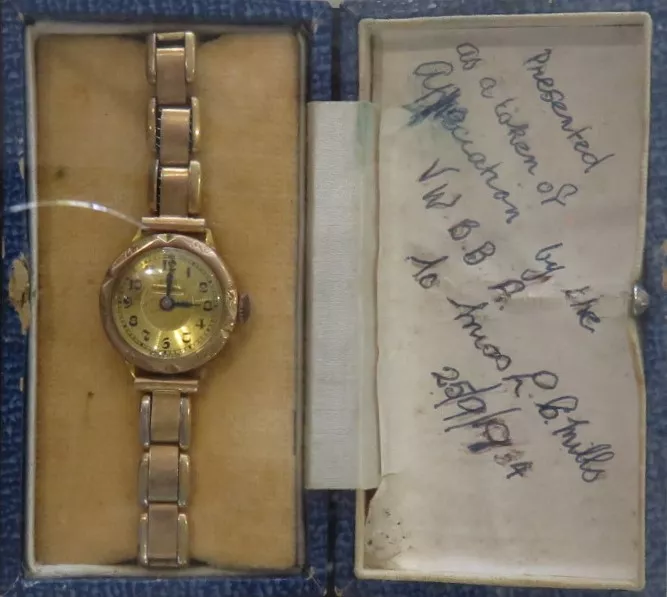The archives at Netball Victoria are full of treasures that help to enhance understanding of how and why the game first began in the late nineteenth century, and in what ways it then developed in Victoria in the early decades of the twentieth century. One of these historical gems is a delicate gold watch encased in a glass display box. This item is a unique artefact, as it is a well-preserved physical reminder of the women who helped make the game of netball what it is today.
As the handwritten inscription shows, on 25 September 1934, the Victorian Women’s Basket Ball Association (the VWBBA, later known as Netball Victoria) presented this watch to Louise C. Mills as a token of their appreciation in awarding her life membership of the Association. Mills (pictured below in 1932), one of the co-founders of the VWBBA, played a central role in the initial administration of netball and is rightly recognised as one of the key proponents of the sport in Victoria, as well as Australia, but details of her story are not widely known.

It was Mills, as Director of the Girls Department of the Young Women’s Christian Association (YWCA) in 1922, who, along with Nonie Hardie as Secretary of the same Department, helped to bring together the various church, “girls” and YWCA teams to form the Melbourne Girls’ Basket Ball Association, thus kick-starting a competition that was later transformed into the VWBBA in 1928. Mills was the inaugural president of the VWBBA and held the position for 12 years, devoting considerable resources to her role by virtue of her formal connection with the YWCA. As a female sports administrator, unusual for this time-period, Mills was able to dedicate much of her working life to developing netball in Victoria, as well as supporting various associations and individual players who competed in national tournaments. She often attended the events herself, as they were important opportunities to discuss netball matters with representatives of other states.
For example, Mills is pictured below (sixth from the bottom left) in a group photograph from the 1929 interstate tournament held in Adelaide. She is holding a kangaroo mascot of some sort, as well as ribbons, perhaps in team colours.

Mills also appeared in a separate Victorian team photograph, autographed by the team, at the same event.

Left to right: Louise Mills (Foundation President), Jessie Barker, Ethel McCarthy, Edith Hull, Margaret Reilly, Evelyn Hassey, Hazel Wilkins, Val Tasker, Nance Tregear, Elsie Johnson (Captain).

The 1930 edition of the Rule Book carried the imprimatur of Mills
Mills was a formidable and influential woman who dedicated her life to women’s sports. Outside of her netball duties, she found time to be president of other sporting associations including baseball, cricket, and amateur athletics, as well as being vice president of the rowing association. A century later, netballers in Victoria still owe a great debt to the original owner of the gold watch, Louise Mills.
However, the journey of the watch did not end with Louise Mills. Reflecting the close relationships that exist within the netball community, Mills later bequeathed the watch to Miss Anne Henderson (13 June 1904 - 29 May 1993). Like Mills, Henderson was a central figure in Victorian netball as an umpire, player and coach. Her extensive influence on the Victorian and Australian netball landscapes included achieving All-Australian umpire status in 1933, representing Victoria as a player in 1933 and 1934, coaching the Victorian state team on various occasions from 1939 to 1958, and the distinction of coaching the Australian team on its inaugural tour of New Zealand in 1948.
In recognition of her outstanding contribution, Henderson was inducted as a Netball Victoria Life Member in 1939, and posthumously elevated to the Hall of Fame in 1998. Henderson’s impact on Victorian netball was initially acknowledged by the state netball stadium being named in her honour in 1981, but while it is no longer called the Anne Henderson Stadium, the recent unveiling of a statue of her at the current site affirms her place as a central figure in the history of Victorian netball. Like Mills before her, Henderson did not keep the watch for herself and later presented it to the Victorian Netball Association, becoming part of their celebration of 60 years of netball in Victoria in 1988.

The story behind this watch reveals much about the history of netball in Victoria, and is a poignant reminder of the key women who were passionate about the game and dedicated much of their life to provide opportunities for people to play, coach, umpire and organise the game they loved. In particular, the journey of the watch from Mills to Henderson highlights the important connections and friendships between various women in netball, and reflects the abiding relationships that continue to be nurtured in Victorian netball communities today. The watch can also take its place next to other more intimate artefacts in the archive, such as personal scrapbooks or players’ wedding photographs forwarded to administrators by former players and coaches. On the surface, the direct relevance of these items to the history of netball might seem questionable. However, these cherished artefacts are not trivial. In fact, they constitute a critical part of the bigger story of netball, one that is not only about the game, but just as importantly about the bonds and relationships formed along the way.
Curatorial Notes:
Anyone with information or connections related to Louise C. Mills and the early years of netball in Victoria should contact Netball Victoria at communications@netballvic.com.au
